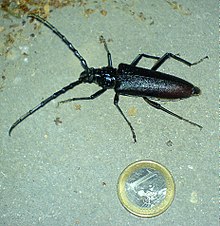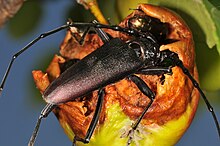Big oak buck
| Big oak buck | ||||||||||||
|---|---|---|---|---|---|---|---|---|---|---|---|---|

Billy buck ( Cerambyx cerdo ), male |
||||||||||||
| Systematics | ||||||||||||
|
||||||||||||
| Scientific name | ||||||||||||
| Cerambyx cerdo | ||||||||||||
| Linnaeus , 1758 |
The Great Capricorn Beetle ( Cerambyx cerdo ), also held Bock , Giant Bock or gemsbok called, is a threatened in Germany by extinction beetles from the family of longhorn beetles , subfamily Cerambycinae . The species is one of the largest beetles in Central Europe. The large oak buck is native to central and southern Europe , also in southern Sweden , in North Africa and in the Caucasus . The course of the Dnepr forms roughly the eastern limit of its distribution. The species has become very rare in Central Europe and has disappeared from large parts of Germany.
features
The black-brown large oak buck is 24 to 53 millimeters long, making it one of the largest beetles in Central Europe. The antennae of the male can reach twice the body length, the antennae of the female reach about body length. The antennae are thickened, punctured, and wrinkled in the first segment. The head, chest, legs and antennae are black, the black wing-covers become lighter to brown-red towards the back. The wing top seam is drawn out into a fine thorn. There is a longitudinal groove on the underside of the first and second hind foot members. The Cerambyx welensii Küster, 1846 and C. miles Bonelli, 1812, found in southern Europe (up to southern Austria and Slovakia) look similar .
habitat
The large oak buck prefers sun-exposed, ailing or dying old pedunculate oaks , less often sessile oaks , beeches or elms . Completely dead trees ( see also: dead wood ) are avoided. Preference is given to trunks that are soaked through in sun-exposed areas, originally probably in oaks - primeval forests in the decay phase and hardwood floodplains , residual occurrences are mainly in old parks and hut forests .
Way of life
The fully developed imago of the great oak buck stays almost exclusively at its birth tree. During the day it hides under loose bark, in old feeding passages or in the leaves in the immediate vicinity of the tree. On warm summer nights with temperatures above 18 ° C, especially in June and July, the Imago flies shorter distances, rarely up to 4 kilometers. The distribution tendency of these very local animals is correspondingly low. Their main activity is between 8 p.m. and 10 p.m. They feed on the sap flow of injured oaks and ripe fruit. The adult animals live a maximum of 46 days (males) or 59 days (females). During its nocturnal activity, the greater oakbuck makes stridulating noises by rubbing the front two of its three breast segments together.
The female lays one to three eggs at a time, a total of 60 to 450, several times in the gnarled bark of old oaks. After up to three weeks, the larvae hatch and eat their way into the cambium for the first winter, into the sapwood in the second year and into the heartwood in the third (up to fifth year) . The nine to ten centimeters long larvae feed on the assimmilates , vitamins and minerals in the tree's sap flow. They pupate in a hooked passage in July or August. After four to six weeks, up to 200 beetles hatch per tree from the end of September to October, which then hibernate for the third time in the pupa cradle. In some cases, it takes four or five years to develop.
Decline and causes of danger
It is no longer possible to understand when the species began to decline. In the forestry industry , the large oak buck was described as a pest . Apparently that was not always the case. In C. G. Kalwers's Käferbuch (approx. 1880) it is mentioned that the Mulmbock is very often harmful, but this was not the case with the large oak buck. While in the 3rd edition "The Forest Protection" of HEß 1898 the beetle is not yet listed among the harmful longhorn beetles, in 1927 the 5th edition of "Forest Protection" (HEß-BECK) already lists the beetle and as a control measure the "trapping the swarming beetle at dusk ”. The trigger for this change in perspective need not necessarily have been an increased incidence of beetles in Germany. It is likely that two major damaging events at the beginning of the 20th century led to mentions in the pest literature. From 1910 to 1917, the large ibex was one of the causes of major oak deaths in the former Yugoslavia , and in the 1920s a calamity occurred in the oak forests of the forest-steppe areas of southern Russia , in which around every third oak on 10,000 hectares was infested.
WECKWERTH described the beetle in 1954 as the “largest wood destroyer” in the longhorn beetle family and states that it can be found in all of Germany's larger oak forests and particularly frequently in the Ukraine. In 1974, SCHWENKE reported that the beetle had lost much of its importance in the last few decades and was only common locally. At that time it was already under protection in some regions. However, it is "still counted among the largest forest pests" in southern and southeastern Europe. KOVACEVIK lists the large oak billy in 1957 among the most important forest pests in Yugoslavia. Here, however, he limits the fact that the large oak buck is more “a technical than a physiological pest”.
The large oak billy is threatened with extinction and is strictly protected according to the Habitats Directive (Annexes II and IV) of the EU. In Germany the species became extinct in Thuringia, in Schleswig-Holstein, Mecklenburg-Western Pomerania, North Rhine-Westphalia and Bavaria only individual occurrences are known, some of which are limited to individual trees. Occurrences are currently known in four locations in Berlin. Extensive deposits are still present in southern Hesse, Baden-Württemberg (Greater Karlsruhe area), Lower Saxony, Saxony, Saxony-Anhalt and Brandenburg. In Germany the large oak buck is classified as a national type of responsibility within the national strategy for biological diversity of the federal government. The IUCN lists the species as vulnerable .
Well-known and persistent causes of decline are above all:
- Conversion of hardwood riparian forests into grassland and arable land .
- Conversion of oak forests into coniferous forests .
- Conversion of primeval forests with mixed oak stands into commercial forests with the use of trees long before biological age death.
- Abandonment or conversion of hat forests into other forests.
- Afforestation of clearings and stock gaps and thus shading of the old oaks.
- Removal or renovation of dying old oaks in parks and other green areas for aesthetic reasons or in the context of traffic safety obligations.
Protective measures and strategies
The decline of the large oak buck can only be slowed down, as oaks only become interesting for this beetle species between 80 and 150 years of age. The spread (repopulation) and the genetic exchange of the populations is no longer given due to the very small critical network distance of less than two kilometers in today's intensively used landscape of Central and Western Europe ( cf. also biotope network ). The remaining and potential habitats of the great oak ibex must therefore be strictly protected and must be preserved through appropriate care and management. This is one of the national priority measures to be pursued according to the Habitats Directive. The conversion of the forests to near-natural forest communities must be pursued, despite the long duration. Larger contiguous deciduous forest ecosystems, especially on natural sites of the English oak, should be left to their natural succession . If necessary, it is necessary to intervene in order to displace neophytes such as robinia and American red oak and turkey , which are direct and strong location competitors. Extensive forestry , the preference for the slow-growing pedunculate oak over pines and a largely renouncement of " tree care " in parks, cemeteries and gardens could slow down the further decline of the species.
literature
- Volker Neumann, Herbert Kühnel: The hero buck. Cerambyx cerdo. (= Die Neue Brehm-Bücherei. Volume 566). Ziemsen, Wittenberg Lutherstadt 1985, 103 pp.
- Volker Neumann: The billy beetle (Cerambyx cerdo L.). Occurrence and behavior of an endangered animal in our homeland. Report of the resettlement campaign in Frankfurt am Main . Antonow, Frankfurt am Main 1996, 69 pages, ISBN 3-924086-81-8
- Manfred Niehuis: The longhorn beetles in Rhineland-Palatinate and Saarland . Fauna and Flora in Rhineland-Palatinate, Supplement No. 26. Society for Nature Conservation and Ornithology Rhineland-Palatinate e. V. (GNOR). GNOR, Mainz 2001, 604 pages, ISBN 3-9807669-0-X
- Jiři Zahradnik , Irmgard Jung, Dieter Jung, Jarmila Hoberlandtova, Ivan Zpevak: Beetles of Central and Northwestern Europe. Parey, Berlin 1985, ISBN 3-490-27118-1 .
Web links
- Species characteristics hero Bock by Ulrich Schaffrath on behalf of HDLGN Kassel 2003 (PDF; 916 kB)
- Leaflet from the Freiburg Forestry Directorate
- Identification aid for related species (French)
- Potsdam is the "world capital of the hero buck"
Individual evidence
- ↑ Ed. G. Jäger: C. G. Calwer's Käferbuch , Stuttgart, approx. 1880, pp. 487 and 489
- ^ Richard Heß: Der Forstschutz , Volume 1, Leipzig, 1898
- ↑ Max Dingler: Heß-Beck Forest Protection , Volume 1, j. Neumann-Neudamm, 1927
- ↑ Walter Weckwerth: Our most famous longhorn beetles and their meaning. For forestry, taking into account nature conservation. (= Die Neue Brehm-Bücherei. Volume 122). 2nd, unchanged edition. Westarp-Wissenschaften, Hohenwarsleben 2004, ISBN 3-89432-587-9 , 40 pages (reprint of the 1st edition, Ziemsen, Wittenberg 1954).
- ↑ • Wolfgang Schwenke (Hrsg.) Et al .: The forest pests in Europe. A manual in 5 volumes - Volume 2: Beetles. Parey, Hamburg and Berlin 1974, pp. 161-163, ISBN 3-490-11216-4
- ↑ Z. Kovazek: The problems of forest protection in Yugoslavia - Overview of the most important forest pests , pest indicator for customer 30, Issue 5, 1957, pp 65-69
- ↑ Landesstiftung: Largest Heldbock beetle occurrence discovered
- ↑ Species in particular responsibility of Germany on the homepage of the Federal Agency for Nature Conservation, accessed on June 3, 2016
- ^ IUCN data set



